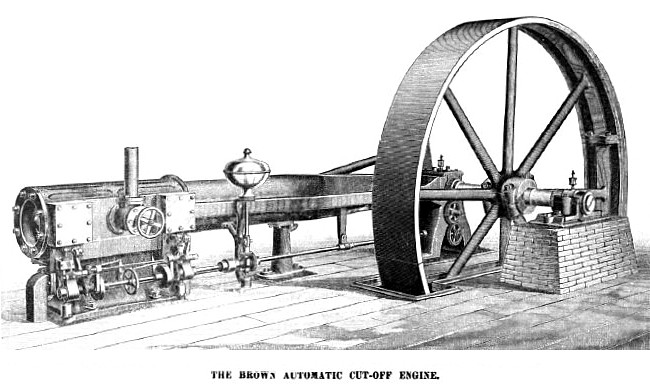|
Title: |
1890 Article-C. H. Brown & Co., Automatic Cut-Off Steam Engine |
|
Source: |
The Steam User 1890 pg 46 |
|
Insert Date: |
4/17/2011 1:45:08 PM |
On the opposite page is shown an engraving of the well-known Brown Automatic Cut-off Engine. In its construction the Brown engine remains practically the same as it has been built during the past twenty years. The governor, however, has been improved so that in case of any breakage steam is shut off and the engine stopped instantly.
The steam and exhaust valves are plain slide-valves, and are operated independent of each other; they are constructed so as to ensure a large area of opening in proportion to the amount of movement, and give free ingress and egress to the steam, and this it is which, together with the quickness of valve movement, leaves the sharp admission corner and the freedom of exhaust, shown in the indicator cards taken from this engine. The valve-seats are also independent, and the part over which the valve travels is raised, so that to true up the seats they may be taken off, and either filed or planed in a little time, the operation making no difference to the height of valve spindle from the seating.
The valve and governor gear, in which the shaft is revolved by the gear-wheels, and, in turn, by means of bevel gearing, drives the governor. It then, through the medium of the friction, device or coupling, revolves the shaft, upon which are the eccentrics; the ends of the straps of which are connected to the horizontal arms, and the ends of the latter extend into the square slot provided in the slide-spindle, and to the catch of the tongue.
As the shaft revolves, the end of the arms will reciprocate vertically in the square slot. The valve-stem is attached to the guide, and in the slot shown in the latter is the tongue pivoted by the pin shown in the guide. The upper end of this tongue has a projecting catch upon it, beneath which stands the end of the arm. Now the induction valve is closed when at the bottom of its travel, and the weight of the valve and stem, and the steam pressure, acting on the area of the valve spindle, serve at all times to keep the valve at the bottom of its travel, unless lifted by the valve-gear, so as to admit steam.
The manner of lifting the valve for the admission of steam is as follows: The end of the arm lifts the valve, and holds it up (and therefore open) so long as the tongue is not tripped; the instant, however, the tongue is tripped the valve closes; this movement, though so instantaneous, being rendered noiseless by means of the air-cushion dash-pot.
It is evident, then, that the whole period of admission is governed by the length of time that elapses between the opening of the valve and the tripping of the tongue.
The position of the eccentric having been determined and fixed, admission will always take place at the same point of the stroke, and hence the supply of steam to the piston will always be equal and constant at the commencement of the stroke, and therefore the cutting off of the steam supply is coincident with the tripping of the tongue.
(These engines are manufactured by C. H. Brown & Co., Fitchburg, Mass.) |
|
 1890 C. H. Brown & Co., Automatic Cut-Off Steam Engine
1890 C. H. Brown & Co., Automatic Cut-Off Steam Engine
|
|